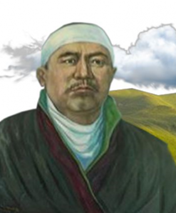 Aset Naimanbayuly is a popular akyn melodist, poet, singer, improviser and composer was born in the eighth village of Temirshi volost of Karkaraly district (now the collective farm of Kyzyl arai, Karaganda region). When Aset was still a boy, his father Naimanbai moved to the village of Bakhty, Urjar district of East Kazakhstan region. Little Aset was identified in Zeynullah’s madrasah. Aset quickly learned to read and write in Arabic. Learning was easy for him. He knew Arabic literacy, eastern poetry. He was often in the village of Abay. His songs are widely distributed among the people.
Aset Naimanbayuly is a popular akyn melodist, poet, singer, improviser and composer was born in the eighth village of Temirshi volost of Karkaraly district (now the collective farm of Kyzyl arai, Karaganda region). When Aset was still a boy, his father Naimanbai moved to the village of Bakhty, Urjar district of East Kazakhstan region. Little Aset was identified in Zeynullah’s madrasah. Aset quickly learned to read and write in Arabic. Learning was easy for him. He knew Arabic literacy, eastern poetry. He was often in the village of Abay. His songs are widely distributed among the people.
According to contemporaries, Aset came to the Koyandy Fair – a kind of pilgrimage place for all prominent Kazakh singers, akyns, and musicians of the last century. In Koyandy, Aset competed with a girl, the poetess Ryszhan. Both were famous, experienced, bold on the tongue, resourceful akyns. They could not defeat each other. Aset brought many new songs from the northern part of Kazakhstan from the trip. Aset was not only an outstanding singer, but also a major akyn-improviser. Moreover, Aset’s aitys testified to his good taste. They were distinguished by the exact selection of words. His poetry is pure, like an ingot of noble metal.
The theme of Aset’s poetry is multifaceted. He was a realist and democratic poetry prevailed in his poetry. Like Zhayau Musa, he wrote poems and songs in which he exposed the bais(the rich), biys, volost rulers. He composed joktau (lamentation songs) for girls, and epigrams, and dedications, and love poems – letters for lovers. Aset also has verses chanting religion, the Muslim faith. It was, so to speak, a tribute to time and environment. The poet was oppressed by the ignorance of the Kazakhs.
In 1923, Aset arrived in the city of Gulju. The poet spoke about the difficult life of the Kazakhs in China. He felt that he could no longer return to his homeland, not see his native land. So absurd on March 22, the great poet and composer Aset Naimanbayev died away from his homeland, in a foreign land, not having time to realize many of his life plans. The people, the heir and the keeper of all that is valuable, enduring from the past culture, remembers their singer and author of many beautiful songs. The song “Aset” is heard in many works of Soviet composers. The main melody of this song was used in Abai’s aria from the opera “Abai”, written by the author of these lines in collaboration with composer Latif Hamidi.
Among many prominent folk composers, beloved singers and akyns, Aset Naimanbayev occupies one of the honorable places. In the works of Aset, the love of the native land is sung, the themes of the family, the equality of women are developed, the call for knowledge, culture, and comprehension of the meaning of life is heard, they reflect the features of nomadic life, history, and ethnography of the Kazakh people. In the work of Aset, the song traditions of Saryarka were developed, at the origins of which were Birzhan sal and Akan seri.
Aset’s musical and poetic talent manifested itself in aitys with the famous akyns Baktybai, Arip, Kali, Samet, Ryszhan, Kempirbai and Malika. The songs “Inzhu-Marzhan”, “Karakoz”, Maida Konyr, “Apitok”, “Gaukhar kyz” and others are widely known among the people. He is the author of the kisadastanov “Akash at”, “Ush zhetim kyz”, “Mulik-Daray”, “Akyrgy soz.” The works of Aset were first published by S.Seifullin in 1925. The first collection of Aset’s works was published in 1968 by compiler B. Adambayev. He included 34 poems including songs, 4 aitys, 4 kissa-dastans. Aitys of Aset with Ryszhan, the poem “Sagila-Amen” and other works have been published many times in our time.
In September 1990, in accordance with the decree of the Government of Kazakhstan, in honor of the 125th birthday of Aset Naimanbaiuly, a literary and memorial museum was opened on September 19 in 1990. In the three halls of the museum, about 1,700 exhibits are exhibited: Aset’s personal belongings, family photographs, the poet’s works, as well as objects providing information about the life and work of Aset Naimanbayev.
Literature:
- Ismailov E. Akyns. – Alma-Ata: Kazgosizdat “Fiction”, 1957. – p. 340
- Aset Naimanbaiuly // Literature of Kazakhstan. Encyclopedic reference book. – Almaty: Aruna LTD LLP, 2010. – p. 528